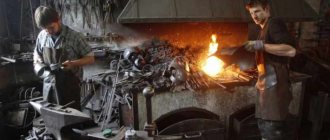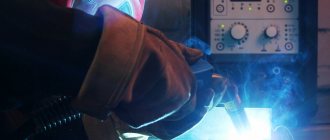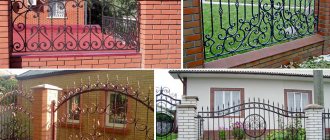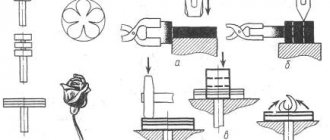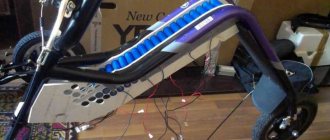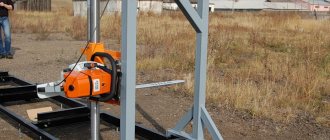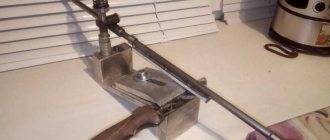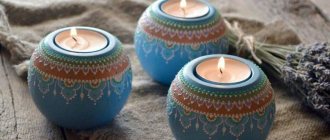Photos of sketches of artistic forging - the best forging you can think of. We will realize any of your fantasies, supported by our technologies. PHOTOS OF COMPLETED WORK>> (Moscow, Moscow region, Tula, Tula region - many completed objects and products)
Forging patterns for stairs and railings are presented in various styles and types of execution (straight, radial, inclined). Sketches are updated, the main types are presented on the website, variations of forging patterns are selected as work on the order progresses.
READY FORGING SKETCHES: gazebos, balconies, gates, fences, railings, gates, stairs. They will serve to determine what you like or will be the basis for us to develop an individual forging pattern for your home...
Our full range of artistic metal forging! >>
We can adapt ANY SKETCH
— Find out more by asking a question: VIBER, WhatsApp +79307910041 (you can send the selected picture)
Sketches of forged stairs
Forged stairs, railings and fences - like the facades of houses and interiors - are created in accordance with style and purpose. Drawings of forging styles - classic, ethnic, modern, art deco, etc. ideally emphasize the image of a house of the corresponding style and project.
Balcony fantasy
Wrought iron staircase Wrought iron staircase
Wrought iron staircase
Forged staircase Forged radial staircase
Wrought iron staircase main entrance
Forged radial stair railings
Wrought iron staircase
Wrought iron stair railing
Wrought iron stair railing Wrought iron stair railing
Forged railings Forged railings
Wrought iron railings main entrance
Wrought iron stair railings Wrought iron railings
Forging stair railing
Wrought iron staircase with radial turn
Staircase with radial forged railings Forged stair railing Stair railing
Stair railing
Wrought iron staircase railing Wrought iron staircase railing
What can you do yourself?
Many believe that it is impossible to create a high-quality forged product with your own hands, others believe that there is nothing particularly difficult in blacksmithing, since our ancestors were successfully engaged in it in ancient times. Both of them are wrong. In order to forge even a small element yourself, you need not only tools and skills, but also knowledge of the properties of metals. Hot forging is hard work in conditions that are very far from office conditions. What to do?
If you don’t want to build a forge and master the technology of blacksmithing, you can limit yourself to an analogue of artistic forging. We will create a welded structure from metal profiles and rolled metal, which can be decorated with ready-made artistic forging parts. For this we will need: a source of electricity; a flat surface for assembling the product; grinder with metal brushes, cleaning and cutting wheels; non-stretch rope, marker; hammer, two pins; welding machine with mask, gloves and electrodes.
Even without a forge, you can eventually learn how to make real masterpieces
We will use metal profiles and rolled metal as materials. It is better to take the latter with a smaller cross-section, since then we can bend it without resorting to special heating conditions.
- Select a drawing. Do not complicate the sketch that you will have to draw, because this is your first product and metal is not a particularly plastic material.
- We buy metal. It should be assumed that the length of a standard rod is six meters. You need to calculate your need for metal and take it with a small reserve.
- Treatment. It is better to immediately clean the delivered material from rust. Then it will be more difficult to do this. To do this, we use a metal brush placed on the grinder.
- Frame assembly. On a flat surface (building berth, workbench, table) we make a frame for the product. Its dimensions are taken into account based on external surfaces. Each of the 4 corners of the frame will have a weld. To prevent the frame from warping, we first grab one of the sides. It doesn’t matter which one comes first. Apply a few drops of welding agent to the upper and lower corners, and then level the diagonal by tapping on the unwelded corners. Then we weld the two remaining corners.
- Measurements. We apply the future drawing on a scale of 1:1 to the surface (table, chipboard, asphalt). To measure its elements we take a rope. We apply the rope to the elements of the drawing, as if to a stencil. This is how we find out the length of the segments into which we cut the rods.
- Deformation. To deform the workpieces, you need to create a device: on a flat surface, weld two studs 2-3 cm from each other. Using them and a hammer, we gradually bend the rods, constantly comparing the result with the stencil.
- Assembly and welding. We lay out the elements on the stencil, assembling the design and trimming the excess. Carefully weld the product on one side and then on the other.
- Cleaning. We clear out everything unnecessary.
- Finished parts. We buy ready-made forging elements that will serve as decoration for the base. We weld them to the places intended for them, and clean the welding points.
- Primer and painting. White primer is used so that imperfections can be seen when painting. The properties of the paint should be compatible with the primer.
- Chic and shine. Special aging or gilding will add attractiveness to the product.
The resulting product will differ little in appearance from a forged one, and with certain skills that are developed with experience, you can learn to create real masterpieces.
Sketches of forged fences, gates and gates
A wrought iron fence, gates and a cozy wrought iron gate that you open every day will give your home a complete architectural look.
Forged gates and wickets
Wrought iron fence Wrought iron gate
Forged gates Forged gates with lamps and fence
Wrought iron gates with lamps and fence Wrought iron gates and fence
Wrought iron fence with lamps and gates
Wrought iron fence Wrought iron gates and fence
Making a snail with a lever
Drawing of a forging machine.
Before you begin the practical part of the work, you need to prepare theoretically. We are talking about calculations and drawings of the machine and its parts. Nobody will give you the exact dimensions, because this is an independent design.
Much will depend on the availability of similar materials, the scale of future cold forging work, the dimensions of the room where you are going to work and many other factors. The main thing is the principles that you need to understand in order to make a homemade cold forging machine with your own hands - the most convenient option for you and only you.
Here's what you need to gather before you begin assembly:
- metal plates or tabletop cloth with a thickness of at least 4 mm;
- metal round pipe for a rack or frame;
- metal rod;
- bearings of different calibers;
- drill;
- welding machine;
- hacksaw for metal;
- M8 bolts.
Basic parts
The twister has only four basic parts
Pay special attention to their preparation and, most importantly, installation:
- frame or stand;
- table top;
- main shaft;
- lever arm.
Rack
Only made of metal, no wooden beams. We place it in a thoughtful place so that you have access to the machine from any side. The machine will be subject to heavy loads, so the best option may be a thick-walled pipe or a metal corner.
Tabletop
Homemade forging machine.
The most important part of the machine, which is best made from a metal plate with a decent thickness, preferably at least 5 mm. In the production of forging machines with your own hands, you cannot save on the thickness of the metal, because the table top and other basic elements will take on a huge load.
The preferred shape is a circle. You need to make two of these tabletops: the second is needed for bending the rods and placing the snails.
Main shaft
From the same metal plate, cut four right triangles with equal sides. Weld the triangles to the bottom of the structure, and their base is in the center of the circle. Another shaft option is not made from triangles, but from a pipe with thick walls of a suitable diameter. Fasten either with bolts or welding.
Lever or handle
And again “as tightly as possible”: attach the lever to the shaft with a ring so that it rotates around it. Attach the bending roller to the top tabletop
It is very important to correctly calculate the length of the lever, which depends on the diameter of the tabletop circle. One rod should be approximately equal to this diameter, the second rod should be longer
Bearings are attached to the lever at its end, this is done to provide greater freedom in the directions of movement of the lever. The lever elements and fixed triangles are secured with a special round nut with a large diameter.
Attachment parts
Be careful here, you need to choose the degree of complexity or, so to speak, “artistry.” We have three options for you.
Simple static snail
In no case do we ignore the requirement in the drawings - cold forging loves precision and thoughtfulness in everything.
Then cut out segments from thick metal strips repeating the snail pattern and weld them as firmly as possible perpendicular to the tabletop. Simple, but not at all ingenious: on this tightly welded snail you can only make the same simple bends without any flight of creative thought.
Metal bending machine.
However, it all depends on what you are going to forge. If, for example, you have plans for a long wrought-iron fence with a simple design, then a simple static snail will be the best option.
Collapsible snail made of removable parts
Let’s say right away that this is the most popular option among amateur craftsmen. The contours of snails are also applied to the tabletop. Threaded holes are drilled along this contour. Snail segments from metal strips are prepared using cardboard templates, and exactly the same matching holes are drilled into them as on the tabletop.
The segments are not welded, but are secured with bolts or cylindrical stops. The main advantage is the ability to bend spiral parts with different radii and different numbers of revolutions.
Modular system with different snails
An option with the greatest artistic freedom for forging with your own hands: instead of segments with stops, removable modules with different snails are used here - both in shape and size. The modules are prepared on separate metal platforms on which the segments are welded.
Of course, you need to tinker a lot with such a machine, but this game is worth the effort: you can forge real metal lace. It all depends on your plans: a simple fence or a lacy gazebo in the garden?
Sketches of forged balconies
Forged balconies, French and ordinary, small and large - for any home they will decorate the facade and emphasize the beauty of a stylish project.
Wrought iron balcony railing Wrought iron balcony
Small wrought iron balcony
Wrought iron balcony railing
Wrought iron balcony railing
Wrought iron balcony Round voluminous wrought iron balcony
Wrought iron radial balcony
Wrought iron balcony
Small wrought iron balcony
Round volumetric wrought-iron balcony
Radial volumetric wrought iron balcony Wrought iron balcony
Wrought iron balcony
Wrought iron balcony
Wrought iron balcony
Wrought iron balcony hand forged
Forged volumetric balcony
Forged balcony Forged volumetric balcony Volumetric forged balcony
Radial wrought iron balcony
Radial wrought iron balcony Wrought iron balcony
Hand forged wrought iron balcony
Wrought iron balcony with pillars
Wrought iron balcony
Wrought iron balcony Wrought iron balcony
Techniques and methods of technology
It is clear that, unlike the hot method, the workpieces are not preheated to forging temperature. Only occasionally can partial heating of the surfaces at the bend be used.
Technologically, this method of metal processing is based on one of the physical properties of metal - plasticity. Rough and non-ferrous metals such as steel, copper, bronze and others, depending on their chemical composition, have the ability to withstand bending, tensile, and tensile loads. This allows them to be processed in various ways without heating.
At the time of production of products, the material can be pressed, which compacts the structure of the metal and, accordingly, makes it stronger. Bending, in turn, adds strength to the product due to additional compression at the bending points.
An important difference between cold forging and hot forging is that there is no high-temperature effect on the metal and, as a result, it does not change its chemical properties, which means there is no need to carry out additional operations: tempering, annealing or hardening.
As a result, cold forging of metal has both advantages and disadvantages.
| Positive properties | Negative properties |
|
|
The main disadvantage of cold metal working is that it can produce a limited number of products.
What technological methods are used to process metal cold?
Sketches of forged lamps and chandeliers
Forged lamps and chandeliers of various sizes - from wall-mounted to large high ones from the 3rd to the 1st floor. Forged lamp posts for streets and gardens. Details that create an atmosphere of style.
Forged lamps
Forged chandeliers
Forged lighting poles
Forged chandelier Forged lamp post Forged fence with lamps Forged lantern Forged fence with lamps and gates Forged gates with lamps and fence
Forged gates with lamps and fence
Advantages of forged products
Despite the fact that many new and modern types of materials have appeared that are suitable for decorating country houses, most people prefer forged products. Although metal can corrode unlike new materials, forging remains in demand for many reasons:
- durability and beauty;
- good protective functions;
- the ability to order a product according to individual sizes, sketches and in any style;
- handmade, products are always combined with other materials.
The list of advantages of artistic forging can be continued, since such products perfectly combine many positive qualities. The photos presented on the websites clearly characterize the beauty, functionality and durability of the products.
The only disadvantages include the high cost of forging and the sensitivity of the metal to corrosion. If the products are too complex in design, they will be difficult to process and paint.
Sketches of forged canopies and entrance groups
Forged entrance groups, entrance stairs and railings are the main decoration of the main facade of your home, inviting you to enter your home with living lines of artistic forging.
Wrought iron entrance staircase Wrought iron entrance group Wrought iron entrance railings
Forged entrance staircase
Wrought iron veranda fencing Wrought iron veranda fencing Wrought iron entrance railings and balcony
Forged entrance group with balcony Forged canopy
Forged metal canopy
Wrought iron canopy Wrought iron entrance
Forged canopy
Forged entrance canopy and building decorative elements
Forged entrance group Forged metal canopy
Cold forging and photos of product samples
Forged products have long been very popular all over the world, and artistic forging occupies a special place. Her beauty fascinates with its graceful and smooth lines, original beauty. Many rich people sought to decorate their home with openwork metal curls of various products that decorated the interior and exterior design of mansions.
Many of us understand what forging is, so we immediately imagine a forge in which a blacksmith operates a hammer, turning a piece of hot metal into a beautiful forged product. This is what happens when it comes to hot forging; in cold forging, everything is different; it does not require a hot workpiece ; the metal can be processed manually at home. How this happens, what kind of process this is, what types of forged products are made in this way can be seen in the photo of product samples and by reading the article.
Sketches of forged gazebos and benches
Forged gazebos and bridges, garden benches and barbecues, arches and flower bed fences will add a touch of poetry to your garden.
Forged bench
Forged bench
Wrought iron street bench
Wrought iron gazebo Wrought iron gazebo Wrought iron gazebo Wrought iron gazebo
Forged gazebo Forged gazebo Forged gazebo Forged gazebo
Assembling the device
This version of the machine is used as an example because of its simplicity. Knowing the basic principles and sequence of equipment design, you can upgrade it at will. To assemble all parts of the equipment into a single whole, you will need to use:
- drill with carbide type drills;
- welding machine;
- a saw cutting metal or a hacksaw;
- metal sheet of the selected size;
- round metal pipe;
- metal rod;
- bearings of different sizes;
- bolts size M8.
To assemble a cold forging machine with your own hands, you need to use a proven sequence of actions:
- Initially, you need to assemble a stand that will serve as a support. To do this, all its components (pipe sections of the same size and the joints between them at the top and bottom edges) must be connected into a single whole. The design may resemble a stool in appearance. The connection is made using a welding machine, and the sections are cut with a saw.
- The next step is cutting the metal sheets. You should get circles of equal diameters and four triangles with equal sides. Triangular-shaped elements must be welded to the bottom of the connected pipe structure in such a way that something similar to a pyramid is formed. The base, which has a wider area, must be welded at the central point of the cut circle.
- Four strips that are located horizontally must be attached to a circle with an already welded element. This should be done using bolts; for this you will need a drill to make the holes.
- The next step is the construction of the handle. To do this you need to use two rods of different lengths. Their sizes can be determined by correlating them with the diameter of the circle. One rod should be commensurate with the diameter, the other should slightly exceed its size. When bending the first rod, you should maintain an angle of 30 degrees. Then weld both rods to each other, and then weld another rod into the lower part. There should also be a jumper between the first two sections, to which a lever is attached by welding, which should maintain the direction towards the structure made of rods.
A bearing for future directional variability in the device must be attached to the end of the attached lever, as well as to the segment located at the bottom of the structure. The upper section serves as a mount for a metal coil, which must be installed horizontally - it makes it possible to bend the metal. On the lower side of the segment, where there is a free end, a hole should be made equal in diameter to the size of the pipe section.
The last step in the algorithm of actions when constructing a machine for cold forging with your own hands will be the connection of the designed handle with a part of the device similar to a “pyramid”. These elements are fixed after putting on the handle with a wide-diameter nut, to which it is first necessary to weld a metal circle, which will allow the template itself to be attached to the machine. Next, the “snail” template is attached by welding.
Conclusion
Anyone who decides to take up forging seriously and make a cold forging machine with their own hands should be very scrupulous at the stage of creating drawings and calculations. Otherwise, the creation process is quite simple, and once you understand the principle of equipment design, you can come up with various variations of it that will help improve the product.
Sketches of forged interior elements
Forged interior elements gracefully emphasize the overall style of the house and in many cases serve as a harmonizing element for large halls, living rooms, fireplaces, wine cellars or unfilled spaces of arches, openings, and winter gardens.
Fireplace accessories Fireplace accessories Wrought iron interior decor hallway
Forged hallway Forged table Forged mirror
Wrought iron furniture
Forged decor Forged table Forged dressing table
Advantages of Forging Processing
Kovkaprom produces and sells artistic elements in many cities of Russia. Their forged elements have very different directions. All these products have several positive qualities:
- Each piece is considered a unique and inimitable creation. Each element has its own individuality.
- Beautiful appearance.
- Forged parts are coated with a special anti-corrosion compound, so these elements can be used for decades.
- Due to the hardness of the metal, such products are always highly durable.
- The details are perfectly combined with various finishing and building materials. This allows us to implement the most original design solutions.
More forging sketches
Above are sketches and drawings of forging of various styles, allowing us to most fully cover the various implementations of forged products. You can see more sketches and drawings when you meet with us or by making a request for a forging design of interest.
Detailed and detailed drawings of projects are worked out to actual dimensions, slightly modifying or supplementing the original drawing with new lines and elements.
Only a true connoisseur understands how forging, which has become a symbol of luxury and prosperity, fills any interior with life. It fits wonderfully into both classic style and modern design trends. Oddly enough, metal objects can add transparency, lightness and even romance to any room.
izogr › Blog › Collection of vector images for artistic forging.
Hi all. I want to share an interesting selection of designs for forging. I am constantly in search of all kinds of patterns and ornaments. And then one day I came across such a collection. I don’t do much ironwork myself, but I also liked the designs and solutions for various products. Please note that the pictures and drawings are in vector format, that is, you can’t just look at them; to view and work you need a vector program, a vector graphics editor such as CorelDRAW, Adobe Illustrator. It’s more convenient and easier for me to work in Korel. The fact that the drawings are vector makes it possible to work with them and change anything. You can also enlarge the drawing to real size without losing quality and print elements in natural size. You can download it from this link from Yandex disk
Forging styles
Forged products fit into the decoration of any character, but must be in exact harmony with the chosen image.
A classic style that never loses its relevance is suitable for a design with simple symmetrical shapes.
In a Gothic interior, complex patterns and weaves in the same symmetry are appropriate.
The Romanesque style is massive and solid. Here thick lines are used, like roots, from which large curls or symmetrical spirals grow.
with baroque , full of grandeur and rich decoration.
The Renaissance is decorated with natural patterns in the form of fruits and leaves, various spirals, berries collected in garlands.
Rococo will be filled with wealth by weightless thin lines. An integral part of this style are playful shapes and elegant voluminous flowers.
Art Nouveau is decorated with asymmetrical, unusual decorations. Bizarre, angular shapes and exotic flowers set this style apart from the rest.
Art Deco is a version of Art Nouveau, which is dominated by geometric shapes, motifs of Egypt and the Ancient East.
Empire style is smooth lines, floral patterns, volutes, the ends of which are twisted into a snail. A floral festoon may be located in the center of the curl.
Russian style , distinguished by its special energy, carved ornaments, characteristic naturalness and simplicity, will be decorated with forged plant patterns with flowers in the center.
into high-tech , distinguished by its functionality and constructivism.
Basic patterns
Since iron can change shape during heat and physical treatment, there are various examples of forged patterns. All of them can be divided into three main groups:
Undoubtedly, the most popular of them are floral forged ornaments. The artful interweaving of branches, flowers and leaves has always inspired artists to create fantastic works. Blacksmiths are no exception in this series. They also often use plant motifs in their work.
For cold working, metal rods are most often used as the main material. They are bent, twisted, flattened, minted, milled and forged. The end result is magnificent works. Here are the main elements and techniques for this type of metal work:
- Curls. The most popular element. It has a huge number of different options and modifications.
- Spirals. Single, double, spatial and others. This is also a very popular technique that makes patterns for forged products memorable and original.
- Cool. Twisting iron bars can be the most incredible experience. The imagination of some authors is amazing.
- Top. A decorative insert or special atypical treatment of the ends of the rods can greatly diversify and decorate any ornament.
- Coinage. The use of chisels and hammers for decorative inserts in forging patterns is a long-proven and often used way to add creativity to a future creation.
- Headings. Cylindrical, cone-shaped, spherical elements made of rolled metal, attached to the end of a rod.
These are not all the techniques in the arsenal of a good master. By skillfully combining them, craftsmen create real masterpieces from ordinary iron.
Application of forging
Forging elements can be found in various furnishings. From the outside of the house to the furniture used in the interior and functional items. Forged bridges in the garden will create comfort and coziness. A fence with forged metal inserts will not only become an elegant decoration for your site, but will also serve as protection for several decades. Gates, street lamps, barbecues, railings, wickets, trellises for plants...
Not every forging master can add a magical touch to the design of a room. This requires an experienced professional artist. Forging is the final stage of interior decoration, the final touch.
Forging materials
Since ancient times, steel has been recognized as the best material for forging, due to its chemical composition. More malleable materials are also used, such as cast iron or copper.
Types of forging
There are two types of forging: hot and cold. They differ in both cost and artistic value. Hot forging is a process that requires enormous effort and special skills. The workpiece is heated to high temperatures. Then, using a hammer, it is given the intended shape. Rivets and clamps are used to connect parts. The work is expensive, but there are only a few similar patterns to be found.
With cold forging, things are a little simpler. Here the matrix and the press work for the master. The original details also look beautiful and rich, but the entire forging pattern is created based on modified but identical details - monograms, curls, leaves. Such patterns are more often used.
Over many years of work, we have gained invaluable experience and skill. We are sure that you will contact us.
We carry out work in Tula, Moscow and the regions of these cities.
FORGE “HERON”
at the address: 300041 Tula, st. Lenina, 12/1 LLC “GERONA” INN 7103518118 official website: www.tula-kovka.ru 8 tel. in Tula: (4872) 79-00-41
Opening hours: from 8-00 to 18-00. Closed on Sunday.
Choosing color and patina for forging >>
Look at the photo of artistic forging:
Equipment for rolling at home
You can buy devices for cold forging yourself or make them yourself from available materials. Initially, you need to create 2-3 basic workbenches to process one rod. The design and complexity of manufacturing depend on the type of work performed. A thorough study of the process will allow you to make the equipment yourself.
To create complex forged products you will need more than one workbench
Gnutik: what products can be created with its help
It is not necessary to create bending drawings for cold forging yourself. It is enough to look at the principle of operation once to make the tool yourself. The machine is a steel tooling, which is divided into three parts. The middle element (lead) is movable; a central roller (wedge) is attached to it, which bends the rod. On the side plates, the rollers are made replaceable and inserted into the groove. By choosing different diameters, you can vary the bending angle of the rod or plate. A lever is attached to the top of the leash, which sets the structure in motion.
Note! Bending a rod requires a lot of force, so attaching the workbench to a movable support will lead to incorrect bending and make work difficult.
The rollers should rotate freely in the holes, which will reduce the force required to bend the plate. Grooves for the rollers can be drilled in several places symmetrically to each other. This will allow you to quickly move the parts, varying the desired bending angle.
The bender helps bend metal rods at any angle
Mechanism for bending metal with a bend:
- a plate or rod is installed between the rollers;
- using a vice, the central roller is pressed against the metal;
- By rotating the lever, the plate moves along the roller, acquiring the desired bend.
For convenience, a dial (a tape with divisions showing the height of the angle) is placed under the central roller. It is used to produce parts with high precision that must fit together perfectly.
The bending tool is quite easy to use.
Snail: a simple tool for creating curls
The second name is a do-it-yourself conductor for cold forging. For manufacturing, you need to familiarize yourself with the bending process, for example, watch a forging video. Then the design itself will not raise questions and will be easy to repeat. The workbench is a frame on which the main matrix or spiral module stands. A rod is driven into the snail and moved around with a metal roller, pressing against the arc. The frame must be made of metal, since wood quickly collapses after prolonged stress. A metal corner, thick-walled pipe or channel are suitable for this purpose.
The machine is designed for two tabletops. One serves as a support and takes on most of the pressure, and the second holds the shape of the snail. Two circles with a thickness of at least 5 mm are cut out. The first part is installed on the frame. The center of the circle is marked on top, and a three- or four-leaf leg is welded to distribute the load.
The upper part of the volute, on which the metal is bent, is called a module. It can be static or typesetting.
The snail tool allows you to create curls from forged metal
A static module is a device for cold forging, designed for bending pattern parts of the same type. The bend radius or angle cannot be changed. Before starting to form the module, markings are drawn on the tabletop. A snail is assembled from metal plates (at least 0.6 mm thick) and welded.
The typesetting module consists of several parts. Its use is the most common for do-it-yourself artistic forging, as it allows you to create elements of different radii. Initially, parts are marked on the tabletop and the grooves are calculated. Removable parts of the snail are cut out of thick metal. Holes for fixing to the tabletop need to be cut only in the middle. Otherwise, the stress is distributed unevenly and the groove breaks faster.
The module for forging with your own hands can be made replaceable. A structure of the required radius is welded onto a metal circle. It is attached to the tabletop with grooves or bolts. To produce elements of different diameters, several modules are made that can be used on one machine.
The typesetting module will allow you to create curls of various radii from forged metal
A rotating shaft and lever need to be secured between the tabletops. It is necessary that the distance between the roller and the module be at least 2 cm, and the shaft stroke must extend beyond the tabletop. A movable element is installed on the lever handle to adjust the radius of the roller stroke.
Wave: how to create and use this tool
Wave is a tool for forging lines like a sine wave. Two rollers are machined to the specified dimensions. The first roller is static (the rod will bend around it), it is fixed on a support. The second is the leading one, it is mounted on a lever and rotates when it comes into contact with the surface. Pressure is generated between the shafts, which acts on the metal and causes it to bend.
The static roller can be machined into the shape of a stepped pyramid. Thus, the radius of the wave can be changed by moving the lever and rod higher by a division. When using such a machine, one side must always be held in order to avoid damaging the bend. To more accurately repeat the wave shape, two static rollers are machined, one of which holds the rod in the desired position, preventing further deformation, and the second is used for bending.
The “Wave” tool will help you make the rod wavy.
Flashlight and twister: features of these machines
A flashlight is a cold forging equipment for working with several rods and creating three-dimensional baskets. To avoid constructing a frame, you can use a regular vice to secure the tool. The tool consists of three parts: two dies and a roller. The matrix can be made of strong, preferably hardened metal 4-5 cm wide.
In each matrix, a central hole is machined into which the roller is mounted. Grooves are made on the sides for installing rods. The second matrix must move freely along the lever, since during deformation the distance between the working surfaces decreases. When the lever is rotated, the rods bend in a spiral, forming a structure similar to a flashlight. Do-it-yourself metal products, which consist of several rods, are secured by welding.
The twister machine has a similar design. However, instead of a shaft, a rod is inserted into the matrix, which is pressed with a plate or bolts. Between them you need to install a movable element that moves forward when the shaft rotates. The rod twists along the longitudinal axis, forming a symmetrical spiral.
You can create forged elements using the flashlight and twister tools
Important! The running matrix should approach static with each rotation. If it is fixed in one position, the master will have to make more efforts to bend the rods.
Briefly about the main thing
Forged patterns turn any gate into an openwork, memorable design. Cold forging products are more common, as they are more affordable and easier to manufacture. A sketch for an ornament made of forged elements can be found on the Internet, and the design itself is easy to assemble with your own hands. The product is assembled from individual parts by welding, folding or caulking. After having graceful metal curves on my gate, I started thinking about similar additions to my garden gazebo.
Question
Write in the comments what you think - should I use bolts and nuts instead of welding?
Fundamentals of metal processing technology
Obtaining a finished element of a fence or a stand for a flowerpot in a flower garden involves several sequential technological processes. The most important of which is giving the rolled product the required shape. Cold forging of metal uses the following types of processing:
- flexible;
- stamping;
- twisting;
- forging;
- rental
The techniques and processing methods used depend on the shape and type of rolled metal.
And here it is necessary to pay attention to the difference between hot forging and cold metal working technology. When the workpiece is heated, the structure of the metal changes, it becomes more plastic, so it becomes possible to give the workpiece the desired shape with a little effort.
During cold forging, the metal does not heat up and its structure remains the same. In this case, you have to put in more effort to get the part of the desired shape. The fact is that when bending or twisting, the resistance of the surface layer of the metal is enhanced by the rigidity of the workpiece shape. And the core, which has high viscosity, takes shape only after overcoming the resistance forces of the surface layers.
Gnitik machine for making curlsSource ytimg.com
Therefore, to obtain certain types of forging, an ordinary hammer is not enough. For successful operation, special devices and devices are required. The peculiarity of the technology is that one type of tool is used to obtain one shape.
Any device for cold forging is a special tool:
- bending of the profile and strip into a curl is carried out on a snail machine;
- stamping, in the manufacture of petals or rosettes, uses a press and punches;
- twisting of a strip, square, pipe is performed on a torsion bar;
- forging or riveting is done on an anvil or using a hydraulic press;
- For rolling, rollers of different profiles and diameters are used.
Applied technological operations
When manufacturing products using the cold method, different operations are used. All of them are based on the deformation of workpieces using machines or special devices.
- Flexible. It is carried out using manual or mechanical equipment. After the end is secured, the workpiece is bent using a lever around a custom-shaped template. Depending on the dimensions of a particular mandrel, curls and monograms of different directions and sizes are created during bending.
- Torsion. Torsion operations of cold forging are performed with clamped ends of the rolled products with the application of significant forces. Only rods with a ribbed section, which include the square and the strip, can be torsioned.
- Broach. This method is used to process the ends of workpieces. As a result of broaching, the rods take on the appearance of peaks or other pointed products. Fences made from such parts look beautiful and impregnable at the same time. Another equally attractive, but safer broaching option is the “crow’s foot”.
- Coinage. Belongs to artistic forging. It is performed by numerous precise blows on the sheet from its back side. As a result of mechanical action, the shape of the material gradually changes, resulting in a three-dimensional pattern appearing on the front side of the workpiece.
Important: Cold forging also includes welding, chopping, cutting, drilling, and grinding techniques. If these seemingly simple operations are performed incorrectly, the product being painstakingly created may turn out to be defective.

